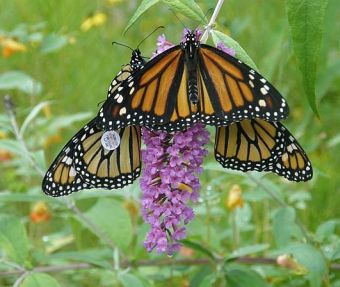 As I write this, eastern monarch butterflies are migrating south to Mexico, a journey of 2,500 miles for those who hatched in Canada.
As I write this, eastern monarch butterflies are migrating south to Mexico, a journey of 2,500 miles for those who hatched in Canada.
What makes such a small, delicate insect travel so far?
Insects have a variety of strategies for surviving the winter. Some overwinter as eggs, others as larvae underwater, in cracks or in mud. Some adults hibernate and just a few – including monarch butterflies – migrate.
Unlike their spring and summer ancestors, the monarchs who emerge from chrysalids in the fall don’t breed. Though they look like adults, the shorter days and cooler nights delay their sexual maturity. Instead, they migrate to twelve mountaintop sites in Mexico. Then in March they travel a short distance north and breed. Succeeding generations live 2-6 weeks and also fly north so that several generations later our first spring monarchs arrive in late April.
How did people figure out that monarch butterflies migrate?
It took over 40 years of tagging and tracking monarchs before Dr. Fred Urquhart found their wintering site in 1976. Even then it was kept secret for a while because the scarcity of sites makes the population vulnerable. Nowadays the wintering sites are eco-tourism destinations where visitors can observe millions of butterflies in the Oyamel fir trees. You can also participate in tagging and tracking programs here at home.
My friend Marcy Cunkelman has been tagging monarchs for many years. Similar to bird banding, monarch tags are uniquely coded stickers applied to the butterflies’ wings. In order to collect monarchs Marcy designed her garden to be attractive to butterflies. In her photo above you can see a cluster of four of them on her butterfly bush. The one on the left is showing its tag.
Marcy’s monarchs have traveled far. In 2003 she learned that one of her butterflies was recovered in Mexico.
Thanks to the Internet, you can watch the monarchs’ migration and find out how to participate in the tagging program yourself at the Journey North and Monarch Watch websites.
p.s. I saw a lot of monarchs migrating on the Sept 14 before Hurricane Ike came to western PA, then none until today. I think a lot of butterflies died during the wind storm.
(Marcy Cunkelman also teaches hands-on programs on monarchs and butterfly gardening.)
Welcome back from your vacation, Kate. It’s good to “hear” your voice again. I was glad to read in your blog the biological mechanics of how monarchs are able to migrate & live for months, having always wondered. I knew they mated, laid eggs & died within a few weeks, on the way north. Now I know they don’t do that, heading south. Mother Nature is marvelous.
Libby Strizzi, New Castle
Thanks for this interesting article, Kate. I’ve been to Marcy’s for the annual bird club picnic. We had the “tour” along with watching her show us how she tags, diff. between the sexes and release a butterfly. Such an interesting naturalist. That’s the perfect photo to accompany your article, also. When the birds are “low” I’ve often “searched for” and taken photos of dragonflies, moths, butterflies, etc. — all just a part of nature, right? Have thought of getting a sassafras bush/tree to attract the Spicebush Swallowtail–diff. look. We have the caterpillar (in my garden) for the Imperial Moth which is large and lovely and likes maples–hope it survives. Welcome back to PA…
On a October vacation in Cape May, NJ several years ago, I mosied out in the morning to the bird sanctuary at the tip of land from where we usually watched the glorious Cape May sunset. I could not believe my eyes as I gazed, unexpectedly, upon the marshes and cedar trees covered by hundreds of migrating Monarchs. After they are warmed by the sun at mid-day, they continue their migration. It was breathtaking! In addition to this visual treat, the experts were demonstrating the banding process held in a little rustic picnic shelter just off the parking lot next to the marshes. I held a monarch and banded it! A once in a lifetime experience.